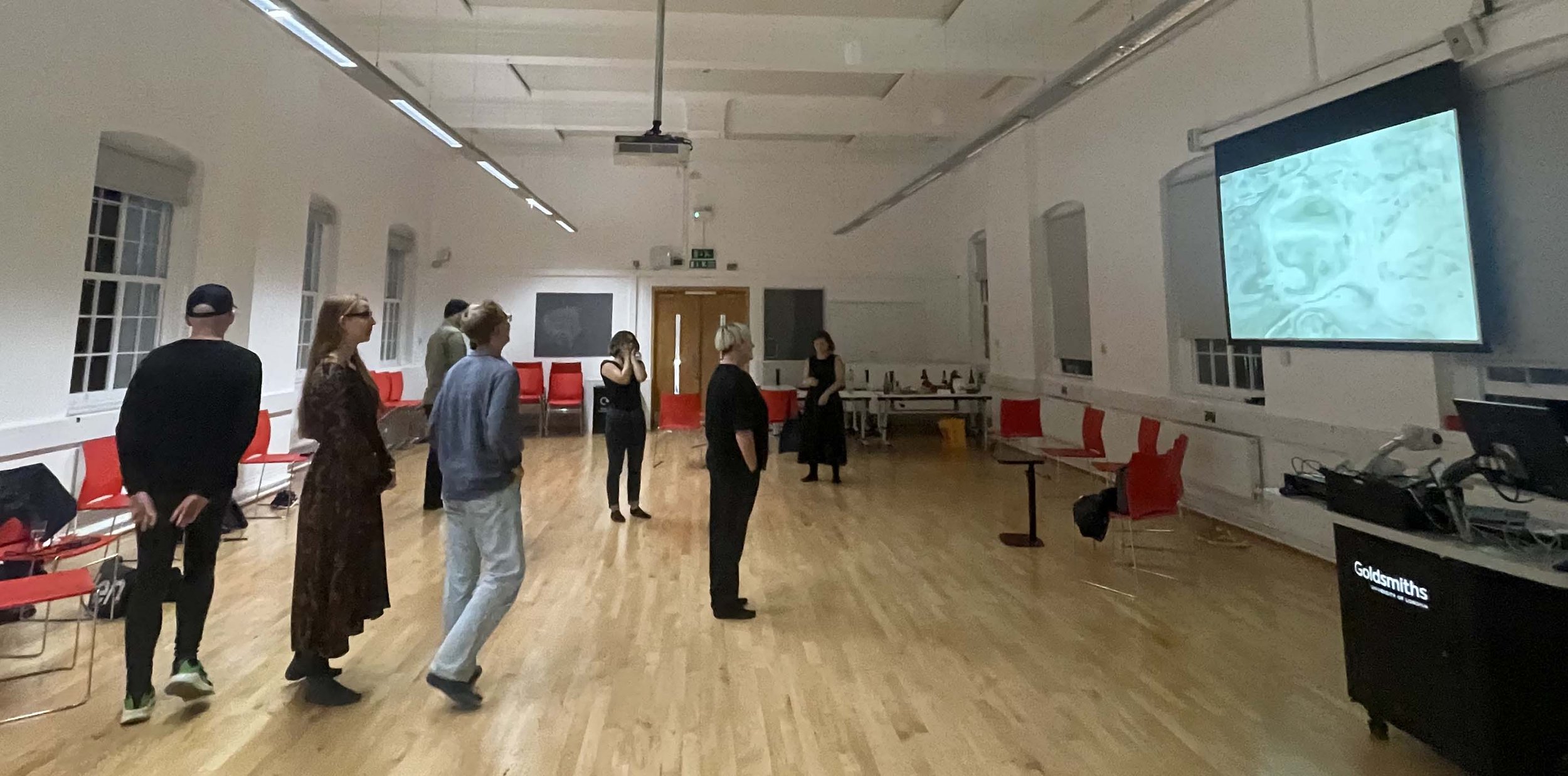In Brief:
This page outlines my research approach, which blends artistic practice with academic inquiry. I explain how I explore memory, maternal trauma, and transnational feminist thought through embodied practices—using autobiographical research, archival studies, and participatory methods like embodied workshops, listening and reading groups, and circular readings. Together, these techniques form a framework for reimagining maternal relationships and collective histories.
Practice-as-Research (PaR)
My research employs Practice-as-Research (PaR), autoethnography, and embodied methodologies to challenge conventional research paradigms and create new ways of engaging with personal and cultural memory. By integrating creative practice with academic inquiry, my work contributes to feminist theory, memory studies, and affect theory.
This interdisciplinary approach emphasises relational embodiment and transnational feminist perspectives, expanding disciplinary boundaries and fostering collaborative, transformative encounters. It enables deeper engagement with “histories that hurt” (Ahmed), reimagining maternal relations and cultural narratives through innovative, embodied methodologies.
Embracing Uncertainty & The Unfitting Practice
A key element of my research is the refusal to conform to fixed formats. My practice embraces uncertainty, indeterminacy, and the unresolved, positioning these as generative spaces for inquiry. The experimental nature of my work—integrating film, embodied workshops, and circular readings—often sits outside conventional academic and artistic structures. Rather than a limitation, this nonconformity fosters new ways of thinking, making, and engaging with personal and cultural memory.
The challenge of “not fitting” is not only an obstacle but an active methodology—one that mirrors the disorientations of transgenerational shame, the ruptures of memory, and the complexities of relationality. My work moves between disciplines, spaces, and registers, making space for the unknown and the unfinished. Instead of seeking resolution, it seeks a contemporary attunement—to breath, to the body, to the material and immaterial traces of the past.
By holding space for that which resists categorisation, my research asks how we can engage with histories that do not sit comfortably, how we listen to what is submerged, and how we create conditions for encounter that do not demand immediate coherence.
This fluid, open-ended approach also allows a broader public to engage with the work, extending beyond academic spaces to connect with communities in Ireland and the Irish diaspora and beyond. Through participatory practice, my work creates spaces where collective memory can be explored outside of institutional frameworks, offering alternative ways of processing personal and historical trauma. In doing so, it reimagines public engagement—not as passive spectatorship, but as an embodied, lived experience of history in motion - thus a universal affect.
Embodied Practice: Thinking with the Body
Embodied practice engages the body—its movements, sensations, and affect—as a site of knowledge production. It challenges traditional discursive models, centering lived experience, relational dynamics, and felt knowledge. By working with breath, movement, and shared space, this approach fosters transformative learning and reshapes how we engage with personal and cultural narratives.
Research Methods
This interdisciplinary, practice-based research integrates autobiographical research, film, performance, archival research, and embodied workshops to explore maternal shame, memory, and transgenerational trauma.
Autobiographical Research: My mother’s experience with dementia serves as a focal point for understanding how shame is transmitted across generations—both linguistically and through the body. This research attends to the disorienting effects of trauma on relational dynamics, offering new insights into how shame is experienced, embodied, and reoriented.
Archival Research: I engage with collections at the Library of Ireland, Radharc Archive, and London Metropolitan University, tracing maternal shame through historical and cultural contexts across Ireland and England.
Embodied Practice & Participatory Research: The durational nature of this practice is central, unfolding across artist residencies, community spaces, and academic institutions. These workshops serve as a critical research framework, creating spaces for dialogue, embodied participation, and shared reflection.
Listening & Reading Groups
The process begins with listening and reading groups, where participants engage with Irish literature and the concept of “shared air.” Through breathwork and collective reading, participants cultivate an awareness of bodily memory, emotional release, and intergenerational trauma, preparing them for deeper engagement.
Embodied Circular Readings
This performative methodology situates histories in action. Drawing from “brave spaces” (A. M. Brown) and contemporary Irish art practice (Jesse Jones), scripted readings allow maternal shame, migration, and dementia to be lived through. Participants move, breathe, and interact with texts, while projected film pieces become integral to the workshop space.
Filmic & Performance-Based Practice
My embodied practice unfolds across three interwoven elements:
Performance:
Explorations of breath as “private,” “public,” and “communal” air.
Non-staged, ephemeral performances, beginning with private readings of my aunt’s letter with my mother and extending into public performances at sites featuring the Virgin Mary.
All performances are documented through handheld recordings, digital video, and photography.
Film & Audio Work:
Filmic breath structures the rhythm of my films—shared breath dictating edits, pacing, and visual sequencing.
The act of cutting on breath allows film to metaphorically breathe, creating a somatic cinematic language.
Embodied Workshops:
Listening, reading, and embodied circular readings, where participants collectively work through shame, memory, and relational rupture.
Films are screened at intervals, exploring how filmic breath and bodily breath interact in shared spaces.
These workshops offer a space to process “histories that hurt” (Ahmed) and foster co-becoming (Irigaray).
This research positions breath as a transformative and relational medium, opening new pathways for exploring trauma, feminist methodologies, and embodied memory.
Key Concepts Explained
At the heart of my practice are the ideas of embodied methodologies and transnational feminisms. Embodied feminisms emphasize the lived, sensory experience of the what I term the feminine-to-come—how our bodies, emotions, and physical movements shape identity and subjectivity. Transnational feminisms extend this perspective across borders, examining how feminist practices and theories interweave diverse cultural histories, migration, and power dynamics on a global scale. Together, these frameworks allow me to reimagine maternal relationships and challenge historical narratives through embodied research and creative practice. For a deeper understanding of these and other key terms and how they relate to my practice, please visit the Glossary page.
Stay connected and keep up to date with my latest research, exhibitions, and creative projects.
LinkedIn | Instagram









